The Definitive List Of Seated Military Press Mistakes

In my opinion, this exercise is one of the best shoulder builders out there.
Basically, the seated military press differs from the regular military press (also known as an overhead press), in that you do it while you’re sitting down instead of standing up.
I personally prefer the seated variation, especially if you are also deadlifting and squatting heavy each week, since it isn’t quite as core intensive.
However, like most of the big, compound movements, the seated military press can be fairly difficult to master in terms of proper form.
And, like the bench press, deadlift, and squat, many people end up doing this wrong – making the exercise much less effective, and increasing their risk of injury.
But not to worry; I am about to clear all of this up for you, so that you can start getting the most out of this exercise next shoulder day.
This article will cover all of the most common seated military press mistakes that I see people making, and how I would suggest correcting them.
Let’s get right into it!
1) You’re not using a full range of motion.

Just as with the squat, the vast majority of people don’t have a proper range of motion when performing this exercise.
In fact, many people only lower the weight until their upper arms are parallel with the floor, meaning that the bar doesn’t travel much further than the top of their head.
If you do this, you are only getting about 1/3 of the range of motion that you should be from this exercise.
So what is the proper range of motion, then?
Well, that is somewhat up for debate, but basically you should at least be bringing the bar down to your chin level.
In my opinion, assuming that you don’t have any preexisting shoulder injuries, you should actually bring the bar down to touch your clavicles for each rep.
If you haven’t done this before, you will have to use a lot less weight than you’re used to, but, in the long-run, it’s a wise move to adopt this habit.
Also, as I have mentioned before, having a strictly defined understanding of each rep you do is important.
Touching the bar to your clavicle area helps properly define each rep that you do – meaning that you’ll have a more solid basis to steadily progress from.
I can’t tell you how many people I see unconsciously limiting their range of motion as they increase weight. Training with a full-range completely eliminates this from happening.
2) You’re letting your elbows flare out.

Many people associate this particular exercise with elbow pain.
And that is unfortunate, since when performed properly this shouldn’t be hurting your elbows at all.
You see, there is a natural tendency to flare your elbows outward when performing the seated military press.
This puts a lot of unnecessary pressure on your joints, and can lead to elbow overuse injuries over time.
To avoid this, make sure that you keep your elbows under the bar throughout the entire lift.
In fact, at the bottom of the movement, your elbows should actually be slightly in front of the bar.
If you have developed bad habits over the years, this may seem strange at first – but trust me, proper elbow positioning will vastly reduce your risk of injury.
3) You’re not locking out the weight.
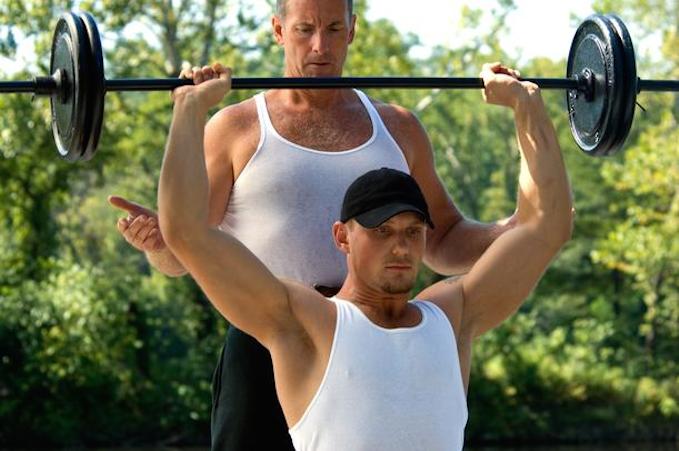
When you do a seated military press, it is important that you lock out your elbows at the top of each rep.
This means fully extending your arms at the top of the movement, with your traps and upper back tight.
If you don’t do this, you will be much less stable overall – and will also risk injuring your elbow and shoulder joints.
4) You’re looking up instead of forward.

For many people, there is a tendency to look up when you’re doing this exercise.
And this makes sense: you want to watch what you’re doing as you press the barbell above your head!
That being said, you must resist this urge, and instead keep your eyes looking forward at all times.
If you look up, it increases the potential for you to injure your neck – and also makes it more difficult to properly lock out the weight on reach rep (see mistake number 3 above).
5) You’re not keeping your chest up.

This is another extremely common mistake that I see all the time.
When you do this exercise properly, you want to make what is known as a ‘big chest’.
This simply means puffing your chest out, and keeping it up throughout the exercise.
Once you start doing this, you’ll find that you feel much more stable overall, and also that it is much easier to touch your upper chest/clavicles with the bar on every rep.
6) You’re gripping too close (or too wide).

Proper grip-width is very important for this exercise.
Basically, you want to avoid gripping too close to your shoulders.
Many websites will advise that you adopt a shoulder-width grip, but this isn’t completely accurate.
If you grip exactly where your shoulders are, you’ll end up touching your shoulders with your hands as you try to complete each rep.
This will feel awkward and will limit your ability to press as much weight.
Instead, you want to be taking a slightly wider than shoulder-width.
Just how wide should it be?
That depends on your frame: the bigger you are, the wider a grip you’ll need to take.
I would recommend experimenting with different grips using very light weight so that you can determine the optimal grip-width for your frame.
7) You’re not planting your feet on the floor.

Just as with the bench press, the proper foot position will help create the stability you need to lift heavy weight.
Don’t do what some people do and lift your feet up, or bounce them about as you’re lifting the weight.
Ideally, you want to take a wider than shoulder-width foot stance, planting your feet firmly on the ground, and driving through your heels as you push out each rep.
The only exception to this rule is if you are sitting in one of those short-back shoulder pressing chairs, which has foot stability pegs appropriately positioned in front of you.
If this is the case, you can experiment putting your feet on those instead, to see which position provides you with the most power/stability.
8) You’re over-arching your lower back.
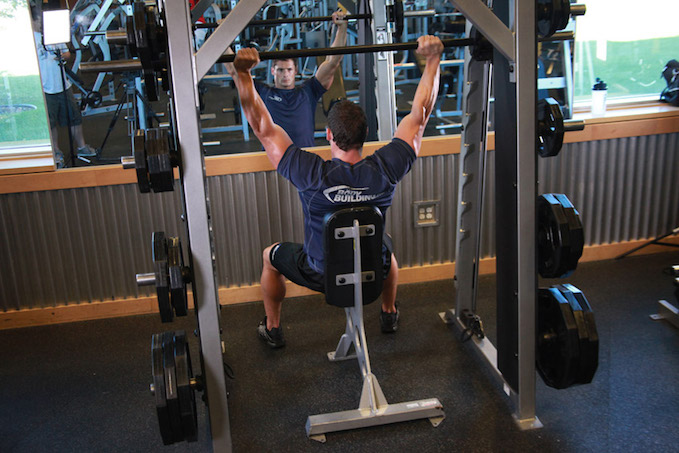
When you start lifting heavier and heavier weights, it is extremely easy to over-arch your lower back.
And mark my words, if you do this too often – and with too much weight – you will hurt your lower back. It is only a matter of time.
To avoid this, you must really focus on keeping your entire body tight during the movement, and try to maintain as much of a natural spine as possible.
If you find that you still end up arching your back on your heavy sets, I would advise lowering the weight until you can do them without significant arching.
9) You’re not keeping your head back.
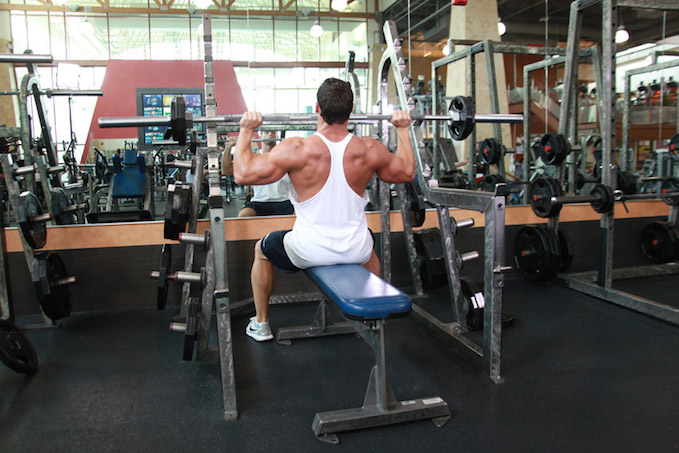
Many people don’t realize this, but you actually want your head to be slightly back when you do a seated military press.
By doing this, it will be far easier to lower the bar down to your upper chest area without it bumping into your chin or nose.
This means that you shouldn’t be doing this exercise in a high-backed chair, since this won’t allow you to put your head back properly.
Instead, it is best to perform this exercise in a low-backed chair, if possible.
In terms of proper form, you head should be back the furthest when the bar as at chest level; then, as you press the bar past your chin, you can bring your head slightly forward as you lockout the rep at the top.
Just make sure to keep your eyes looking forward, not up, at all times (see mistake number 4).
10) You’re doing behind-the-neck presses.
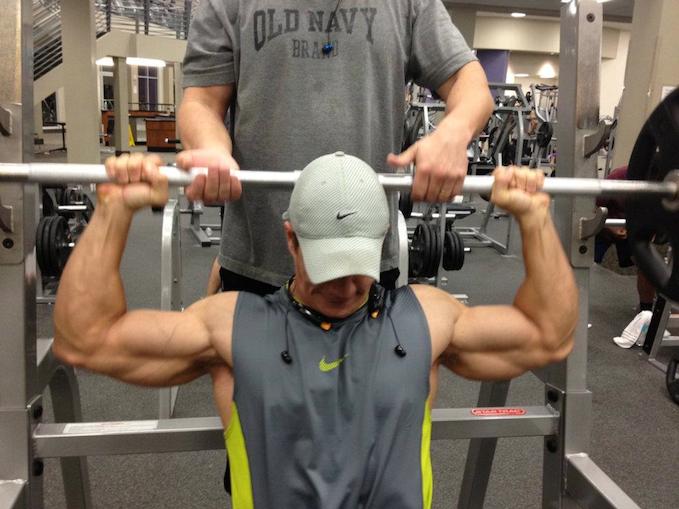
I saved perhaps the most egregious mistake for last…
For whatever reason, many people perform a seated military press by bringing the bar behind their head.
You must never, ever do this – and if you’re doing it at the moment, I implore you to put an end to this foolishness.
The vast majority of people won’t have the rotator cuff flexibility to press significant amounts of weight behind their heads.
Yup, if you do behind-the-neck presses, you are practically inviting a rotator cuff injury to happen to you.
And as someone who has suffered through this painful, slow-healing injury, you really, really want to avoid it.
Stay away from this dangerous variation at all costs!
Ready to start building 3D shoulders?
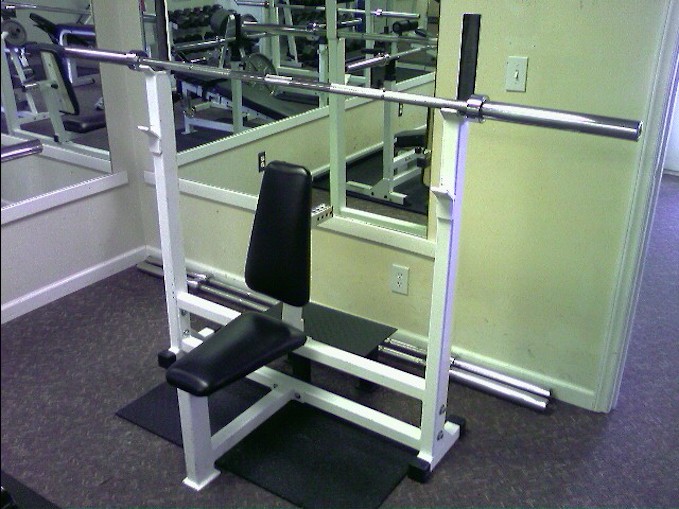
The seated military press is a staple of many effective strength building routines.
In fact, I would venture to say that this lift (or its standing variation) should be your primary shoulder exercise.
Yes, it is that much more effective than any combination of raises that you might also be doing.
So, after reading this article, my hope is that you’ll be able to iron out any seated military press mistakes that you’re currently making – and will see massive strength and size gains as a result!
Just don’t be afraid to drop your weight as you correct your mistakes and start doing it properly. Always remember the importance of proper form.